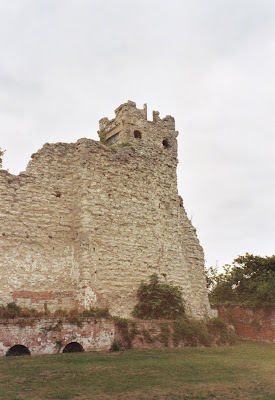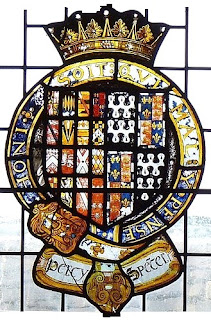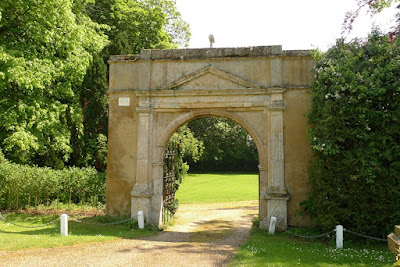 |
St Katherine of Alexandria
[An original early 14th-century
illumination by Simone Martini] |
The exact number of children born to Edward I and his first wife Eleanor of Castile is far from certain. Through 13th-century administrative records, the existence of twelve can be proven by name: Katherine,
Joan, John, Henry, Eleanor, Joan of Acre, Alphonso, Margaret, Berengaria, Mary, Elizabeth, Edward. In his thoroughly researched 1984 article on the subject [
*1], historian John Carmi Parsons speculated on the existence of additional children, from various pieces of evidence. Thirteenth-century administrative records, specifically the Calendar of Liberate Rolls, refer to Eleanor's confinement in December 1264 and churching in February 1265 [
*2]. Dr. Parsons concluded that this January 1265 birth was of Joan, a daughter referred to eight months later in September 1265 as being entombed in Westminster Abbey. This allowed him to associate the unnamed daughter mentioned in a Patent Roll entry of June 1264 [
*3], whose burial in Westminster Abbey is referred to in the Liberate Rolls in October that year [
*4], with
Katherine, a daughter of King Edward, whose obit of September 5th is given in the necrology of Christ Church, Canterbury, written sometime after Edward's accession to the throne in 1272 [
*5].
Katherine was the only child of Lord Edward and Eleanor of Castile to appear on record in the first ten years of their marriage. Eleanor was just turning thirteen when she
married the fifteen-year-old Lord Edward in November 1254. On leaving Castile, the young couple went to Gascony, a territory that Edward had been granted earlier that year. There they held court until October 1255, when Eleanor traveled to England. Dr. Parsons mentions previous speculation that a daughter of the couple known to have been buried at the Dominican priory in Bordeaux, could have died due to a premature birth during the spring that the youthful Edward and Eleanor were newlyweds in Gascony [
*6]. But that assumes their marriage was immediately consummated and Eleanor conceived quickly. Thirteen would have been viewed as dangerously young for an important princess such as Eleanor to begin a sexual marriage. Childbirth for a young woman just entering puberty could be fatal, or harm the womb, preventing any future children, bringing to naught the efforts put forward by both families to achieve the sacred alliance.
Because Eleanor’s own mother, Jeanne of Ponthieu, was in her later teen years when she married Ferdinand III of Castile, that marriage was immediately consummated and the first child, Ferdinand, born within twenty months of the wedding. But Eleanor of Provence was thirteen when she married Henry III of England, and it took three years for her first child, Lord Edward, to be born, implying sexual co-habitation with her husband was delayed until she was fifteen. It’s very likely the same pattern followed for Eleanor of Castile, with her marriage to Lord Edward not becoming sexual until about 1257.
It was almost a year after her marriage - in October 1255 - that Eleanor first arrived in England and finally met the parents and younger siblings of her new husband. Henry III had planned for her arrival in London to coincide with the feast day of his beloved saint, Edward the Confessor, on 13 October. But her London entry was delayed because the Castilian princess arrived at Dover so poorly arrayed that purchases had to be made to equip her for a proper ceremony. She didn't arrive in London and offer at St. Edward's shrine in Westminster Abbey until October 17th [
*7]. It's also noteworthy that Lord Edward was not with her. He didn't arrive in England until some weeks later, and had wished to remain in Gascony, only returning on his father's orders [
*8].
 |
Princess Katherine Plantagenet (1253-1257),
youngest child of Henry III |
Well aware that her own childbearing would be expected to begin in the near future, Eleanor likely took a special interest in the infant Katherine, the youngest child of the English king and queen. She was a small miracle to her royal parents, for eight years of barrenness passed between the birth of the next youngest sibling Edmund in 1245, and Katherine's birth in 1253. But the little princess, who turned age two a month after Eleanor's arrival, would prove to be deaf, a disability which would have become evident to the Plantagenet royals about this time. As Eleanor began to form her personal relationships with the members of her husband's family, much of the focus would be on this afflicted toddler. She died in May 1257, seventeen months after Eleanor’s arrival.
How close were Edward and Eleanor in the early years of their marriage? Most historians, including the couple's modern-era biographers Michael Prestwich and Dr. Parsons, agree that the union was a great success on a personal level, with Eleanor accompanying Edward on Crusade, and on his military campaigns in Wales in the 1280s. It's a completely valid assumption when their marriage is viewed in its entirety. The evidence from the 1250s and early 1260s, however, paints a different picture. In their first ten years of marriage (eight of which were appropriate for sexual relations), administrative records show that only two children were conceived, the latter conception not occurring until April 1264. Eleanor's fertility from that point forward, with children coming regularly on an average of every two years, shows that biology was not the issue. Edward, and not his wife, must then be the reason for there only being one conception for the couple prior to 1264.
Unlike his father Henry III, who was twenty-eight when he married, and his grandfather King John, who was twenty-three at his first marriage, Lord Edward was only fifteen. He needed the opportunity to sow wild oats, and could not be expected to view his marriage with a princess just entering puberty with the same level of maturity as his father had viewed his own marriage. In order to fulfill the terms Alfonso X of Castile had set for the marriage, Henry III had granted Lord Edward several territories - Gascony, Ireland, the earldom of Chester and Bristol Castle - in the months preceding the ceremony. The teenaged prince would have been as excited (if not more so) about familiarizing himself with the officials and extents of his new territories than about familiarizing himself with a new bride whom he was not yet able to touch, and whose upbringing had been in a faraway court, with customs and ceremonies to which he only had a brief exposure. The fact that he wished to stay behind in Gascony when she made her first trip to England in October 1255, indicates he didn't have a very strong desire for her companionship at that point.
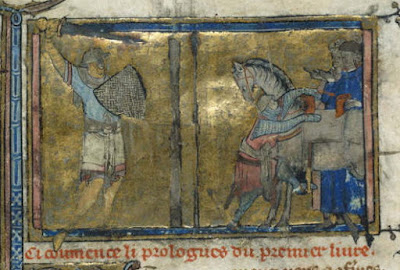 |
| Knight in training - early 14th-century |
For the first few years of his marriage, Lord Edward would be in extensive training as a knight and military commander. He fought in his first tournament, at Blythe, when he was seventeen, and embarked on his first military campaign in Wales at about the same time [
*9]. He was starting to make his own alliances, primarily with the barons of the Welsh Marches, and promote a political identity for himself independent of his royal parents. These were years of male-bonding, feats of arms, carousing and wenching. It may have been easier for Lord Edward to view his wife as a virginal princess than as a partner with whom he could share his plans and ideas for the future. She likely was settled in the court of his parents, especially the household of the queen from whom she would be receiving training, than accompanying her husband on his knightly adventures. The administrative record backs this up, with Eleanor appearing in it during the years 1255-1259 associated with her royal in-laws rather than her young husband [
*10]. Though no doubt each strongly felt the expectation that they should produce an heir, their youth may have made it difficult to develop the familiarity and trust that would be the ingredients of the mature years of their marriage.
Dr. Parsons suggests that Eleanor and Lord Edward’s daughter Katherine may have been born in April 1261, as there is a passage in one manuscript of the
Flores historiarum that states Henry III’s daughter Katherine died on 21 April 1261 when about eight years old. As administrative records prove that Katharine actually died on 3 May 1257, Parsons surmises that the
Flores may have confused the younger Katherine’s birth with the death of the elder one. If so, Katherine was born at a time when there were rifts between her father Lord Edward and his own royal parents, caused by Edward’s public support for his father’s kinsmen the Lusignans over the Savoyards, the favored kinsmen of his mother, as well as his enthusiastic support for Simon de Montfort, Earl of Leicester, and the other barons pushing for reform in the royal administration. Henry III even came to believe, while he was in France from November 1259 to April 1260, that back in England his twenty-year-old heir was trying to depose him. It took some time for father and son to be reconciled that year, one of the conditions being that Edward remove himself from the stormy political situation in England, which he did by leaving in November to participate in tournaments in France [
*9].
If Katherine was born in April 1261, then the royal family would have been aware of Eleanor of Castile’s pregnancy when she accompanied Lord Edward to France in November 1260, and his return to England from April to July 1261 to deal with the growing crisis there around the reforms the barons were trying to impose on the king (and Lord Edward’s) administrations might have immediately followed the birth of his first child. It is not certain if Eleanor returned to England with him in 1261, or remained on the continent. It is certain that they both returned to England in late February 1262, and accompanied Henry III and Eleanor of Provence to France in July that year [
*11]. With Eleanor went Alice de Luton, who had been one of Lord Edward’s nurses in his early years, a possible indication that Eleanor either already had, or was expecting, her first child [
*12]. The king and queen returned to England in the fall of 1262, but Edward and Eleanor remained on the continent, recruiting for a campaign in Wales against Llywelyn ap Gruffydd, whose position had strengthened so much it threatened the English commander there. Eleanor proved her loyalty and worth to her husband, by helping to provide him mercenary soldiers from Ponthieu [
*13]. When Lord Edward returned to England late in February 1263 for the Welsh campaign that spring, he brought with him his wife, the Ponthevin mercenaries she’d helped him to recruit, and, most important of all from a dynastic perspective, a daughter. No English chronicle records the birth of a child to Edward and Eleanor until their firstborn son in 1266. As there is no record of Henry III rewarding the messenger who brought him the news of the birth of his first Plantagenet grandchild, he must have been nearby when Eleanor of Castile gave birth. The likeliest date for her first child to have been born then is during the latter half of 1262, when Henry III, Queen Eleanor, Lord Edward and his wife were all together in France.
Lord Edward's choice of the name of Katherine for his firstborn child was a symbolic display of his commitment to his parents, who had greatly mourned the death of their daughter Katherine, and to the future of the Plantagenet dynasty. Eleanor of Provence had a special devotion to the medieval cult of
St. Katherine of Alexandria, viewed as the most important of the virgin-martyrs in heaven, and as a paradigm for young noblewomen to be learned and chaste. A phial of oil from her monastery on Mount Sinai was brought to England by Edward the Confessor, and housed at Westminster Abbey. Most importantly, Queen Eleanor’s youngest child had been born on the 25th of November, the feast day of St. Katherine [
*14], and from that point on, the queen revered the saint, taking a direct personal interest in the hospital of St. Katherine by the Tower, dedicated to the saint and traditionally one of the institutions under the patronage of England’s queen consorts. Katherine was not a name used by the Plantagenets until Eleanor of Provence, nor was it used at all by either the paternal or maternal families of Eleanor of Castile. By naming her first daughter Katherine, the younger Plantagenet wife was showing symbolic respect to both the saint herself, and to England’s queen at a time when the latter was at her lowest popularity.
 |
| King Henry III Tower, Windsor Castle |
Whatever the date of her birth, Katherine was the only child in the nursery of her parents for the entire span of her short life. That nursery was Windsor Castle, the royal residence beloved by her grandfather the king, who had established it as the nursery for his own children. The last few months of Katherine’s life were the lowest point in the reign of her grandfather Henry III. The barons of the kingdom, led by Simon de Montfort, where pushing for reforms as laid out in the Provisions of Oxford. Henry III was not about to give up an iota of the authority that his ancestors had given their blood to achieve, and that God had sanctioned as theirs by right, and received a papal bull in 1261 that absolved him from the Provisions. Lord Edward was summoned back to England by his father the king to deal with the crisis caused in the Welsh Marches by Llywelyn ap Gruffudd, set up his wife and little daughter in Windsor Castle in February 1263, and embarked on a military campaign in the Marches in April and May, though little was achieved. Meanwhile, Simon de Montfort had returned to England that spring and the crisis the royal family was facing with the barons was increasing dramatically. Henry III and the Queen were forced to take refuge in the Tower, while Edward was at Clerkenwell outside London. Desperate for funds, Edward and a gang of knights gained entry into the New Temple and ransacked its treasure. This caused the furious Londoners to rise in rebellion, forcing Edward to retreat to Windsor. When his mother the Queen tried to join her son, her boat was pelted by a mob on London Bridge and she had to turn back to the Tower. Henry III agreed to the baronial terms in July 1263, but the 24-year-old Lord Edward defiantly refused to capitulate and moved to his castle at Bristol, where his bullying gang of knights caused the townspeople there to rise in arms and besiege the castle. The bishop of Worcester negotiated a truce [
*15]. Lord Edward set himself up as the military arm of the royal family, leaving negotiation and diplomacy to his father the King and his uncle Richard of Cornwall. Hot-headed young knights, with lordships in the Welsh Marches, flocked to his side. They set up headquarters at Windsor Castle, where Eleanor of Castile and little Katherine had remained. It was the favorite residence of Henry III and he had established the nursery for his children there. Little Katherine was no doubt enjoying the royal nursery, but the castle itself was in full military mode, far different from the childhood her father Lord Edward had experienced there. Mercenary soldiers from Ponthieu and her father’s household knights mingled with the steward, John de Weston, and damsels of her mother’s household. The threat of military conflict filled the air, and strategies were discussed endlessly.
Lord Edward accompanied his father the King to Amiens in France in January 1264. Simon de Montfort and the barons had given their consent to French arbitration. Louis IX of France was not about to have the royal authority of his brother-in-law inhibited by one iota, and his decision was to completely annull the Provisions of Oxford. Little attention was paid by the barons however to the French king’s edict, and civil war became inevitable. Henry III issued a summons for the feudal host to meet him at Oxford, ostensibly for a campaign against Llywelyn of Wales, but in reality to muster a force to fight Montfort and the other rebellious barons. Lord Edward left Windsor Castle in early April to join his father’s host, ordering Eleanor of Castile not to leave the castle under any condition [
*16]. He would never again see his firstborn child, little Katherine.
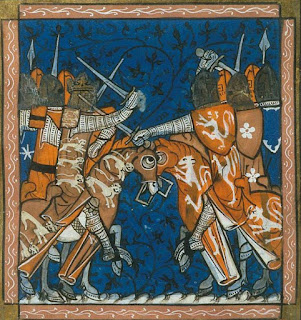 |
| Battle of Lewes |
The Battle of Lewes on 14 May 1264 was devastating for the Plantagenets. Lord Edward conducted himself well, but was forced to surrender himself and his father the king when Montfort and the barons threatened to execute Richard of Cornwall, Philip Basset and other captured royalist leaders. Edward’s one hope was that his giving himself up as a hostage allowed his Marcher allies to go free [
*17]. When news reached Eleanor of Castile at Windsor that the King, Lord Edward, Richard of Cornwall and his son Henry of Almain were all now hostages of Montfort and the barons, and that the Queen and her younger son Lord Edmund had fled England for the continent, she must have felt isolated and panicked. She and her daughter were the only Plantagenets on English soil not in Montfort’s hands.
Orders were issued in June for the garrison Edward had left at Windsor to surrender and vacate the castle, and for Eleanor to take her daughter, her steward, and her household and remove to Westminster Palace [
*3]. The orders were under the seal of Henry III, but Eleanor and the garrison were not fooled. They knew the King was in Montfort’s hands and that it was the baronial leader who wanted Eleanor and her daughter, who could be seen as rallying points for royalists, not to mention Eleanor’s continental relatives in Ponthieu and Castile, more firmly under his thumb in London, his seat of power. With Eleanor at Windsor Castle was Joan, the heavily pregnant wife of Henry III’s half-brother William de Valence. She was ordered to go to a nearby religious house and await her delivery. What was likely only known to Eleanor and her attendants in June 1264 was that she too was pregnant. The orders were re-issued a week later, which shows that Eleanor and the garrison tried to delay surrendering Windsor, but Montfort was at the height of his power and could not be denied [
*18].
Medieval London was a very unsanitary city, and a cauldron for contagion. The Plantagenets raised their children far away from it, in the cleaner air of Windsor Castle and other country royal residences. Eleanor no doubt dreaded taking her young daughter to a city that had proven itself not only hostile to the Plantagenets, but carried the ever-present threat of disease as well. The date of her arrival at Westminster is not known, nor can it be determined if she was able to see her royal father-in-law before Simon de Montfort moved the king and the royal household to Canterbury in August in order to consult with the bishops in the cross-channel negotiations being conducted with the papal legate and the French king. Whatever Eleanor’s fears for her child’s safety, they were fully realized when young Katherine died in September at Westminster Palace.
 |
| Great Hall of Westminster Palace, as it would appear in the 14th-century |
God had once again shown his displeasure with the Plantagenets. For Eleanor of Castile, the death of her only child while her husband was still a prisoner of the barons, and the future of the entire dynasty was in question, was a heavy blow. Her only consolation would be the knowledge that she was again with child. Lord Edward received the news in captivity at Wallingford Castle, for an attempt by some of his knights to free him from there had failed [
*19]. For King Henry III, the death of his first grandchild was a direct blow from God. The king had spent most of his days since Montfort had taken control of the government, in prayers to his favourite saint, Edward the Confessor. He managed to interrupt this long enough while in Canterbury during the month of September, to insure that the obituary of his granddaughter Katherine was entered in the necrology of Christ Church. Katherine was buried in Westminster Abbey by the third of October. She was only the second Plantagenet to be interred there, following her namesake toddler aunt.
Eleanor of Castile would have had no choice as to where her daughter was buried: Henry III was placing his bloodline in the hands of the Confessor, and the family would lie as close to his shrine as possible until the Second Coming. But the fact that, out of the many subsequent daughters Eleanor of Castile would go on to bear, none bore the name Katherine, may indicate Eleanor’s personal feelings regarding the responsibility of her royal in-laws as to the danger the Plantagenet dynasty faced in the dark months of 1264. Eleanor of Castile supported the cult of St. Katherine with far less vigour than that of her mother-in-law Eleanor of Provence. Over a hundred years passed before a Plantagenet princess was again given the name of the virgin saint: in 1372, John of Gaunt gave the name Katherine to his fourth daughter (who, incidentally, went on to be Queen of Castile), though his reasons for doing so were personal and had little to do with the saint.
Notes
[
*1] John Carmi Parsons, "The Year of Eleanor of Castile’s Birth and Her Children by Edward I",
Medieval Studies, Volume 46 (1984).
[
*2]
Calendar of Liberate Rolls [
CLR]
1260-1267, pp. 150, 160.
[
*3] 17 June 1264, St. Paul’s, London.
“To Eleanor, consort of Edward the king’s son. As the king wishes that she shall retire by all means from the castle of Windesor where she now is, he commands her to go out with her daughter, John de Weston, her steward, William Charles, her knight, her ladies, donzels (’domicellis’) and the rest of her household, harness and goods, and to come to Westminster to stay there, until the king shall make further order; and not to fail as the king undertakes to excuse her to E. her lord and will keep her harmless, and receives them into his safe conduct" [
Calendar of Patent Rolls [
CPR]
1258-1266 (1910): 325.]
[
*4] Oct. 1264, Canterbury.
“Allocate to William son of Richard, keeper of the exchanges of London and Canterbury, in the issues thereof, 113s. 4d..................delivered in the wardrobe at Canterbury to the said master Henry [de Gaunt] on Wednesday after St. Faith, 14s. delivered the same day for 12 gold obols (obol de murc’a) and 15s. delivered on Wednesday after the Nativity of St. Mary for the like; and 4 marks in payment for two cloths of gold (’pannorum ad aurum’) adorned with wheels (rotatorum), delivered to Robert de Anne the king’s almoner to the use of Katherine the deceased daughter of Edward the king’s firstborn; and 40l. delivered to the said almoner to make offerings on the day of [the said Katherine’s] burial” [
CLR 1260-1267 (1961): 142-143.]
[
*5] This necrology manuscript is now housed in the British Library: British Library Arundel 68, fol. 40v. I haven't examined the original manuscript.
[
*6] Parsons, "The Year of Eleanor of Castile’s Birth and Her Children by Edward I", p. 257. Interestingly, the only source for this daughter is an administrative entry from 1287 which shows that the queen provided a gold cloth for the anniversary of her daughter on 29 May at the Dominican priory in Bordeaux, where the child was buried (P.R.O. E 36/201).
[
*7] John Carmi Parsons,
Eleanor of Castile: Queen and Society in Thirteenth-Century England (1995), pp. 17, 262 n. 30.
[
*8] Michael Prestwich,
Edward I (Yale English Monarchs Series, 1988), p. 15.
[
*9] Michael Prestwich, "Edward I (1239–1307)",
Oxford Dictionary of National Biography (2004).
[
*10] Parsons,
Eleanor of Castile, pp. 17, 262 n. 32.
[
*11] Prestwich,
Edward I, pp. 37-38; Parsons,
Eleanor of Castile, pp. 23, 264 n. 46.
[
*12] Parsons, “The Year of Eleanor of Castile’s Birth and Her Children by Edward I”, p. 258.
[
*13] Parsons,
Eleanor of Castile, pp. 23-24, 264 n. 47.
[
*14] Mary Anne Everett Green,
The Lives of the Princesses of England from the Norman Conquest, Volume 2 (1857), p. 270.
[
*15] Prestwich,
Edward I, pp. 38-40.
[
*16]
Ibid., pp. 41-43; Parsons,
Eleanor of Castile, p. 24.
[
*17] Prestwich,
Edward I, pp. 45-47.
[
*18] Parsons,
Eleanor of Castile, pp. 24, 264 n. 49.
[
*19] Prestwich,
Edward I, p. 47.



